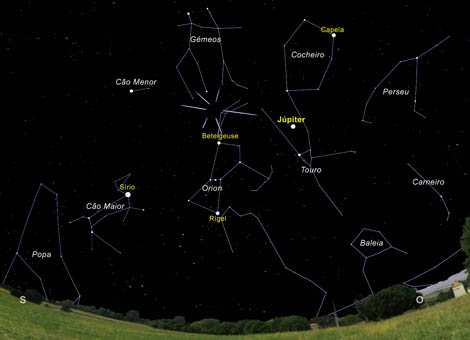
October 5th is a day of ephemeris. In 1910 the monarchy in Portugal was overthrown, and our country became a republic. In 1962, the European Southern Observatory was founded (ESO), one of the most important European scientific organisations.
And in 2012, around 22:30 pm, our Moon and the planet Jupiter are born close together (less than 1 degree apart). This planet returns triumphant to the night sky, being born earlier and earlier. On the 30th, it starts to appear above the horizon, to the east, around 19:30.
If one appears, the other disappears. In the first days of the month, and for those who have an unobstructed western horizon, they may still be able to glimpse the planet Mars even at dusk.
On the 5th, for example, the sun sets around 19:10 pm, and at that time Mars is only 15° above the horizon. As the days go by, it appears lower and lower, not even visible at the end of the month.
But despite being important, October is not just the 5th. This month, we can see the Moon passing very close to almost all the planets visible to the naked eye, being 3 degrees from Mercury on the 6th, at 6 degrees from Venus on the on the 12th and at 2 degrees from Mars on the 18th (although this encounter is unlikely to be seen). There is still an approximation of the Moon to Uranus, on the 27th, but this planet is at the limit of what our eyes can distinguish, so it is only visible in dark skies, without light pollution.
As for the phases of our natural satellite, it is in a waning quarter on the 8th, passing through New Moon at 15, crescent at 22 and almost at the end of the month, the Full Moon appears on the 29th.
Stele showers for two in October. First, the little-known Draconids, beaming towards the constellation Dragon, and a maximum predicted for the early evening of day 7. This meteor shower is quite unpredictable, as it can reach a maximum with half a dozen meteors per hour. , how can “explode”, with hundreds per hour. The Dragon is between the two Ursas (major and minor), and in Portugal it is a circumpolar constellation, that is, it never passes below the horizon.
The other meteor shower in October is that of the Orionids, which radiate slightly above the star Betelgeuse in the constellation Orion. This star is a red giant, more than a thousand times larger than our Sun, and is located in the upper left corner of the constellation, above the "three marias".
The peak of activity of this rain is difficult to calculate, and this year it is predicted to occur before the dawn of the 21st. At most, around 25 meteors per hour are predicted (in dark skies).
Good remarks!
Author Ricardo Cardoso Reis (CAUP)
Science in the Regional Press – Ciência Viva


















Comments